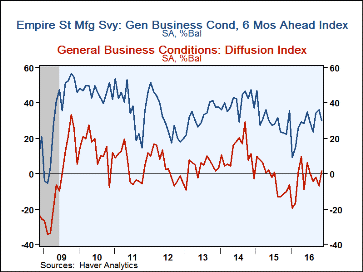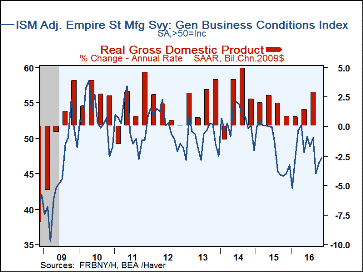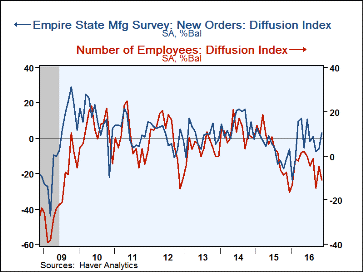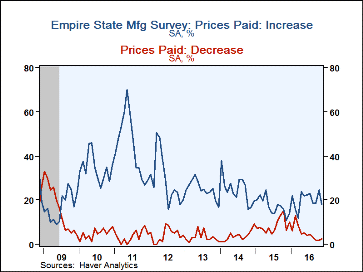 Global| Nov 15 2016
Global| Nov 15 2016Empire State Factory Sector Index Turns Positive
by:Tom Moeller
|in:Economy in Brief
Summary
The Empire State Factory Index of General Business Conditions for November posted its first reading above zero since July. It rose to 1.5 from -6.8 in October. Expectations had been for -3.0 in the Action Economics Forecast Survey. [...]
The Empire State Factory Index of General Business Conditions for November posted its first reading above zero since July. It rose to 1.5 from -6.8 in October. Expectations had been for -3.0 in the Action Economics Forecast Survey. The data are reported by the Federal Reserve Bank of New York and reflect business conditions in New York, northern New Jersey and southern Connecticut.
Based on these figures, Haver Analytics calculates a seasonally adjusted index that is comparable to the ISM series. The adjusted figure improved to 47.2 from 46.5. It was the highest level in three months. Since inception in 2001, the business conditions index has had a 64% correlation with the change in real GDP.
The new orders as well as the shipments readings both returned to positive territory following a few months of negative readings. Delivery times also slowed, but inventories fell more rapidly. The employment index declined. During the last ten years, there has been a 70% correlation between the index and the m/m change in factory sector payrolls. The average workweek figure was fairly stable m/m, but down sharply over the last three.
The prices paid index reversed improvement during the prior two months. Eighteen percent of respondents reported paying higher prices while three percent paid less. The index of prices received eased to 2.7.
The six-month ahead reading fell to the lowest level in three months due to lower expected orders, shipments and inventories. Prices paid improved slightly as did employment. Capital spending plans were steady, but up from earlier lows.
The Empire State figures are diffusion indexes which are calculated by subtracting the percent of respondents reporting poorer business conditions from those reporting improvement. Thus, they have a good correlation with growth in the series covered. The data is available in Haver's SURVEYS database. The ISM-adjusted headline index is calculated by Haver Analytics. The series dates back to 2001. The Action Economics figure can be found in Haver's AS1REPNA database.
| Empire State Manufacturing Survey | Nov | Oct | Sep | Nov'15 | 2015 | 2014 | 2013 |
|---|---|---|---|---|---|---|---|
| General Business Conditions (Diffusion Index, %, SA) | 1.5 | -6.8 | -2.0 | -10.1 | -2.4 | 11.9 | 3.9 |
| General Business Conditions Index (ISM Adjusted, >50=Increasing Activity, SA) | 47.2 | 46.5 | 45.0 | 45.0 | 48.9 | 52.4 | 50.0 |
| New Orders | 3.1 | -5.6 | -7.5 | -11.7 | -5.6 | 7.9 | 1.2 |
| Shipments | 8.5 | -0.6 | -9.4 | -3.0 | 4.0 | 12.1 | 4.5 |
| Unfilled Orders | -12.7 | -10.4 | -11.6 | -15.1 | -10.5 | -9.0 | -8.7 |
| Delivery Time | -5.5 | -11.3 | -6.3 | -11.3 | -5.3 | -5.2 | -3.5 |
| Inventories | -23.6 | -12.3 | -12.5 | -7.5 | -7.1 | -1.8 | -5.7 |
| Number of Employees | -10.9 | -4.7 | -14.3 | -8.5 | 2.7 | 10.9 | 3.7 |
| Prices Paid | 15.5 | 22.6 | 17.0 | 0.9 | 8.8 | 20.9 | 21.5 |
| Expectations 6 Months Ahead | 29.9 | 36.0 | 34.5 | 23.3 | 30.4 | 40.2 | 33.2 |
Tom Moeller
AuthorMore in Author Profile »Prior to joining Haver Analytics in 2000, Mr. Moeller worked as the Economist at Chancellor Capital Management from 1985 to 1999. There, he developed comprehensive economic forecasts and interpreted economic data for equity and fixed income portfolio managers. Also at Chancellor, Mr. Moeller worked as an equity analyst and was responsible for researching and rating companies in the economically sensitive automobile and housing industries for investment in Chancellor’s equity portfolio. Prior to joining Chancellor, Mr. Moeller was an Economist at Citibank from 1979 to 1984. He also analyzed pricing behavior in the metals industry for the Council on Wage and Price Stability in Washington, D.C. In 1999, Mr. Moeller received the award for most accurate forecast from the Forecasters' Club of New York. From 1990 to 1992 he was President of the New York Association for Business Economists. Mr. Moeller earned an M.B.A. in Finance from Fordham University, where he graduated in 1987. He holds a Bachelor of Arts in Economics from George Washington University.










